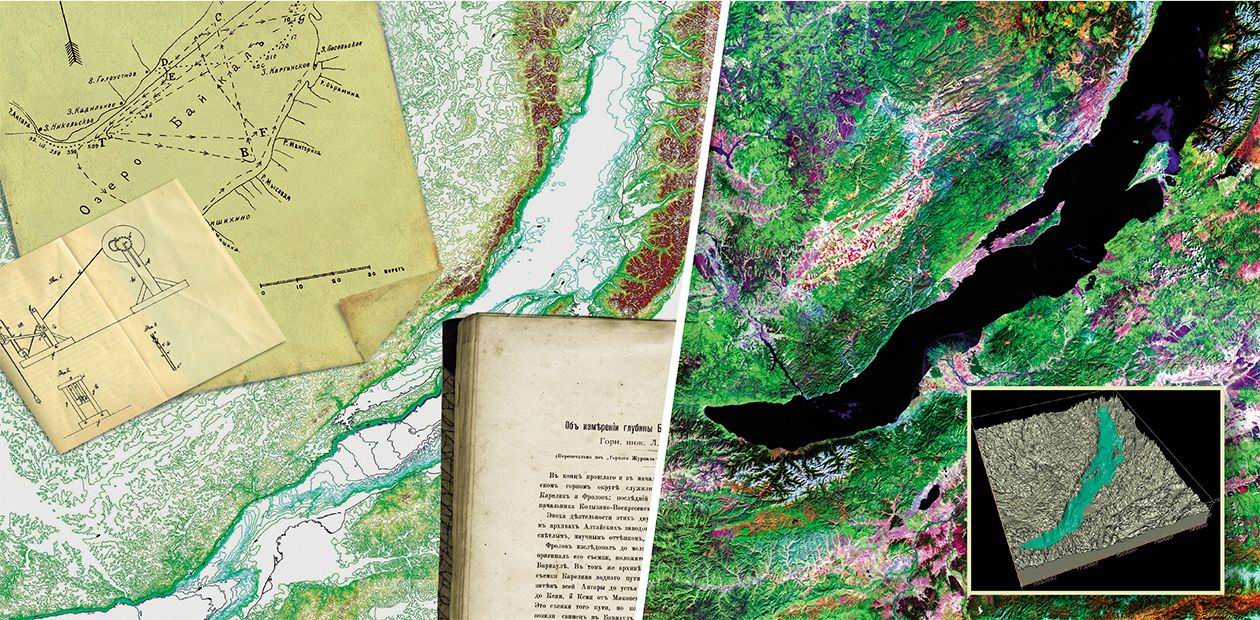Geographical Discoveries: Tour around Baikal Bottom
Would you like to wander around the bottom of the ancient lake, climb underwater ridges, take a closer look at the canyons, and admire the relief of the lake bottom from a bird’s eye view? Nothing is easier in the high-tech epoch! Just insert the disk with a new bathymetric map of Lake Baikal into your computer’s CD-ROM drive!
From Karelin to Vereshchagin
The story of mapping the Lake Baikal bottom began almost 30 years ago in the 1970s when cartographers did not have any idea about digital technologies. To be more precise, this date may go back to the remote past — to 1798, when mining engineers Sergey Smetanin and Egor Kopylov under the leadership of mining chairman Nikita Karelin first measured the lake depth. One of 28 sounding measurements yielded a depth of 1238 m. Thus, Lake Baikal was ranked among the deepest water bodies of the world.
This article appeared thanks to joint efforts undertaken by the international team formed by the initiative of Michael Grachev, Member of the Russian Academy of Sciences, Director of Limnological Institute, Siberian Branch of the Russian Academy of Sciences. The work was carried out within the INTAS project 99-1669“A New Bathymetric Map of Lake Baikal”, © INTAS Project 99-1669 Team, October 2002, http://allserv.ugent.be/~mdbatist/intas/intas.htm
The project was headed by:
Prof. Pavel Sherstyankin, Limnological Institute SB RAS, Irkutsk (Russia);
Prof. Marc De Batist, University of Ghent, Ghent (Belgium);
Rear-Admiral Sergey P. Alekseev, State Research Navigation Hydrographic Institute of the Ministry of Defense of the Russian Federation, St. Petersburg (Russia);
Prof. Miquel Canals, University of Barcelona, Barcelona (Spain).
Robert Hus and Francois Charlet, post-graduate students of Prof. Marc de Batist, contributed much to the success of the undertaking.
In the beginning of the 20th century numerous hydrographic expeditions cleaved through the Lake Baikal waves. However, their results were mainly related to the relief of the coastal line of the lake. In 1925, the USSR Academy of Sciences prepared a long-term project on studying the bottom relief of Lake Baikal under the leadership of Soviet hydrobiologist Gleb Vereshchagin. To execute the project, Limnological Station was set up that developed later into Limnological Institute. Within the framework of the project a lot of geographical discoveries were made, including the discovery of the underwater ridge named Akademichesky, which divides the central and northern basins of the lake. The data obtained within this project became the basis of the first detailed bathymetric maps of Lake Baikal, for which Vereshchagin was awarded with Bid Gold Medal at the International Limnological Congress in Rome.
NAVY gives a helping hand
Let us come back to the recent history. Between 1979 and 1987 the expedition of the Central Administrative Board for Navigation and Cartography of the Navy performed echo-sounding measurements aimed at bathymetric survey of the entire Lake Baikal. In deep parts of the lake, the echo-sounding measurements were made at 1.5 km isobath intervals, while in coastal waters, every 250—100 m and less. The accuracy of determination of geographic coordinates was up to several meters. Thanks to this titanic work, a detailed four-sheet bathymetric map of Lake Baikal at a scale 1:200,000 was published in 1992.
However, an endeavor for perfection is unlimited. The new map had certain shortcomings. For example, there were some significant discrepancies between the echo-sounder measurements and actual water depths. This surprising fact is explained by the difference between the characteristic acoustic velocity distribution in Lake Baikal and the echosounder design speed. The information on the depths over 1 km was presented very poorly. Therefore, the accuracy and reliability even of this map for deep regions of Baikal left much to be desired.
Recent history
In 1999, Limnological Institute initiated setting up of an international team to compile a more precise bathymetric map of the lake, a user-friendly digital map, using ALL the available sounding data and high technologies.
The international scientific team consisted of researchers from Renard Center of Marine Geology (University of Ghent) and Spanish United Research Group on Marine Geoscience (University of Barcelona). Russia was represented by scientists from Limnological Institute (Irkutsk) and State Research Navigation Hydrographic Institute at the Ministry of Defense of the Russian Federation (St. Petersburg).
Bays of Frolikha and Ayaya are the most beautiful bays on Lake Baikal. Not far from them hot underwater springs (vents) with unique biota, bacterial mats, were found at a depth of 400 mAll the echo sounding measurements carried out by the Navy more than 20 years ago were reprocessed, adjusted to the speed of sound in Baikal water, and digitized. These results were as much as possible merged with the data obtained before: acoustic and coast-line topographic data, as well as the seismic profiling data collected by the Belgian expedition team. The resulting digital database contained about 1.5 million water-depth points! The two and a half years of joint work of the international research team of hydrographs, hydrophysicists, and geologists yielded a new electronic bathymetric map of Lake Baikal.
Baikal in digital setting
The mapping resulted in more than one map. The tiny CD contains a bathymetric map with isobaths every 50 m; various color bathymetric maps; maps of slopes of the basins and shaded-relief map, on which numerous underwater faults are seen; maps of bottom slopes, etc. Colorful three-dimensional images of various parts of the lake and its surroundings impress much an unsophisticated glance.
Secondly, all the maps and spatial images have been designed for interactive work: any site of the map can be diminished or enlarged as required.
Thirdly, while compiling the map, the researchers made some geographical discoveries. For example, it was found out that the bottom in the deepest parts of depressions was not flat as it had been expected, but covered with irregularities and lumps, which recently found mud volcanoes could logically fit. The new map made it possible to establish that Baikal is deeper and ‘fuller’: all the main morphometric characteristics of the lake appeared to exceed the data obtained before. According to the new map, the maximal depth of Lake Baikal makes up 1,642 m, which is 5 m deeper than the value obtained using deepwater submersible “Pisces”.
The new map most resembles a fascinating computer game. However, it is not only a wonderful gift for all those who admire the unique lake. It can be used as a tool in research and economic activities, ecological and economic forecasting, as an aid for geologists and limnologists, biologists, and hydrophysicists.
Reference
1. A New Bathymetric Map of Lake Baikal. INTAS Project 99-1669 Team, Оctober 2002. http://allserv.ugent.be/~mdbatist/intas/intas.htm
2. Kolotilo L. G., Sherstyankin P. P. Tables of Sound Speed in Lake Baikal Water and Tables of Depths Measured by Echosounder. Vladivostok, 1985.
3. Bukharov A. A., Fialkov V. A. Baikal in Numbers. 2001.
4. Kolokoltseva E. M. Morphometric Characteristics of Lake Baikal. Mesozoic and Cenozoic Lakes of Siberia. Nauka, Moscow, 1968.












